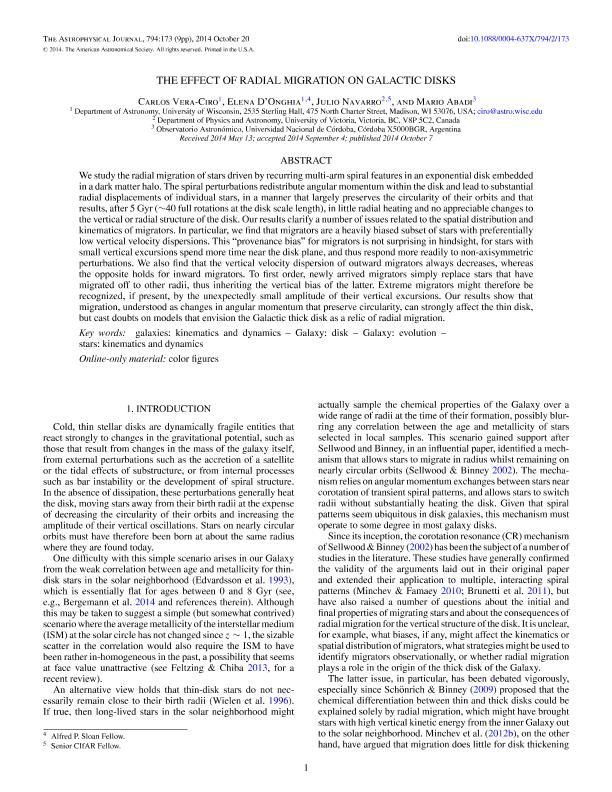Mostrar el registro sencillo del ítem
dc.contributor.author
Vera Ciro, Carlos
dc.contributor.author
D'Onghia, Elena
dc.contributor.author
Navarro, Julio
dc.contributor.author
Abadi, Mario Gabriel

dc.date.available
2018-01-03T22:09:23Z
dc.date.issued
2014-10
dc.identifier.citation
Abadi, Mario Gabriel; Navarro, Julio; D'Onghia, Elena; Vera Ciro, Carlos; The effect of radial migration on galactic disks; IOP Publishing; Astrophysical Journal; 794; 2; 10-2014; 173-181
dc.identifier.issn
0004-637X
dc.identifier.uri
http://hdl.handle.net/11336/32256
dc.description.abstract
We study the radial migration of stars driven by recurring multi-arm spiral features in an exponential disk embedded in a dark matter halo. The spiral perturbations redistribute angular momentum within the disk and lead to substantial radial displacements of individual stars, in a manner that largely preserves the circularity of their orbits and that results, after 5 Gyr (~40 full rotations at the disk scale length), in little radial heating and no appreciable changes to the vertical or radial structure of the disk. Our results clarify a number of issues related to the spatial distribution and kinematics of migrators. In particular, we find that migrators are a heavily biased subset of stars with preferentially low vertical velocity dispersions. This "provenance bias" for migrators is not surprising in hindsight, for stars with small vertical excursions spend more time near the disk plane, and thus respond more readily to non-axisymmetric perturbations. We also find that the vertical velocity dispersion of outward migrators always decreases, whereas the opposite holds for inward migrators. To first order, newly arrived migrators simply replace stars that have migrated off to other radii, thus inheriting the vertical bias of the latter. Extreme migrators might therefore be recognized, if present, by the unexpectedly small amplitude of their vertical excursions. Our results show that migration, understood as changes in angular momentum that preserve circularity, can strongly affect the thin disk, but cast doubts on models that envision the Galactic thick disk as a relic of radial migration.
dc.format
application/pdf
dc.language.iso
eng
dc.publisher
IOP Publishing

dc.rights
info:eu-repo/semantics/openAccess
dc.rights.uri
https://creativecommons.org/licenses/by-nc-sa/2.5/ar/
dc.subject
Galaxies: Kinematics Ansd Dynamics
dc.subject
Galaxy: Disk
dc.subject
Galaxy: Evolution
dc.subject.classification
Astronomía

dc.subject.classification
Ciencias Físicas

dc.subject.classification
CIENCIAS NATURALES Y EXACTAS

dc.title
The effect of radial migration on galactic disks
dc.type
info:eu-repo/semantics/article
dc.type
info:ar-repo/semantics/artículo
dc.type
info:eu-repo/semantics/publishedVersion
dc.date.updated
2018-01-03T20:09:00Z
dc.journal.volume
794
dc.journal.number
2
dc.journal.pagination
173-181
dc.journal.pais
Reino Unido

dc.journal.ciudad
Bristol
dc.description.fil
Fil: Vera Ciro, Carlos. University of Wisconsin; Estados Unidos
dc.description.fil
Fil: D'Onghia, Elena. University of Wisconsin; Estados Unidos
dc.description.fil
Fil: Navarro, Julio. University Of Victoria; Canadá
dc.description.fil
Fil: Abadi, Mario Gabriel. Universidad Nacional de Cordoba. Observatorio Astronomico de Cordoba; Argentina. Consejo Nacional de Investigaciones Científicas y Técnicas; Argentina
dc.journal.title
Astrophysical Journal

dc.relation.alternativeid
info:eu-repo/semantics/altIdentifier/url/http://iopscience.iop.org/article/10.1088/0004-637X/794/2/173/meta
dc.relation.alternativeid
info:eu-repo/semantics/altIdentifier/doi/http://dx.doi.org/10.1088/0004-637X/794/2/173
Archivos asociados
